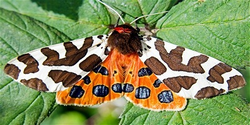Copy of `USGS - Macromoths of the Northwest`
The wordlist doesn't exist anymore, or, the website doesn't exist anymore. On this page you can find a copy of the original information. The information may have been taken offline because it is outdated.
|
|
|
USGS - Macromoths of the Northwest
Category: Animals and Nature
Date & country: 01/07/2013, USA
Words: 50
|
abdomenOne of the three primary body segments, along with the head and thorax, characteristic of insects. The abdomen in moths is typically elongate and contains the reproductive organs.
anal anglethe angle along the edge of the wing created by the transition from the outer margin to the inner margin.
antennae(singular: antenna) variously shaped filamentous sensory organs located on the top of the head.
area, analthe area on the wing between the outer margin and the inner margin, proximal to the anal angle.
area, apicalthe area on the wing below the apex.
area, basalthe area at the base of the wing where the wing is attached to the thorax.
area, discalthe area of the wing containing and immediately adjacent to the discal cell.
area, medianthe central area of the wing.
area, midcostalthe area in the center of the front edge of the wing.
area, postmedianthe area on the wing immediately distal to the median area and proximal to the submarginal area.
area, subanalthe area on the wing proximal to the anal area.
area, subapicalthe area on the wing proximal to the apical area.
area, submarginalthe area on the wing proximal to the outer margin.
banda wide area typically extending more than half the distance along the width or length of the wing and often demarked by lines and associated with a particular area on the wing.
band, innera wide area near the base of the wing demarked by lines extending the width of the wing.
bara narrow, short mark on the wing; a very short dash.
butterflythe adult of a species of Lepidoptera with knobbed antennae, day-flying, and typically brightly colored.
cell, discalan area of the wing delineated by the discal veins in the discal area.
dasha narrow, short mark extending less than half the distance along the width or length of the wing.
dentatetooth-like markings, typically along one side of a line.
eyespota round multi-colored spot on the forewing or hindwing.
falcatecurved into a sickle-shape, often used to describe a wing with the tip extended into a subtle or elongate, curved point.
femurthe third segment of the true legs preceeded by the coxa and the trochanter. The femur is the first leg segment that is elongate, followed by the tibia which is also elongate.
filiformthin and threadlike, typically used to describe long and slender antennae.
forelegthe first pair of true legs nearest the head. The forelegs are ventrally attached to the first thoracic segment.
forewing(s)the wing(s) attached to the second thoracic segment, the first pair of wings from the head.
headOne of three primary body segments characteristic of insects, along with the thorax and abdomen. The head contains the antennae, mouthparts, eyes, and brain.
hindwing(s)the wing(s) attached to the third thoracic segment, the second pair of wings from the head.
linea narrow mark, extending more than half the distance along the width or length of the wing and associated with a particular area on the wing.
line, basala line in the basal area near to where the wing attaches to the thorax.
line, mediana line in the median area of the wing.
line, postmediana line in the postmedian area of the wing.
line, submarginala line in the submarginal area of the wing.
macromoththe adult of a species of Lepidoptera with the tips of antennae tapered; in the Pacific Northwest the species occur in one of the following families: Arctiidae, Dioptidae, Drepanidae, Epiplemidae, Geometridae, Lasiocampidae, Lymantriidae, Noctuidae, Notodontidae, Saturniidae, Sphingidae, and Thyatiridae.
margin, costalthe front edge of the wing.
margin, innerthe back edge of the wing.
margin, outerthe distal edge of the wing.
micromoththe adult of a species of Lepidoptera with the tips of antennae tapered, typically small bodied; many families of micromoths occur in the Pacific Northwest; not a butterfly or a macromoth.
palps, labialsmall, segmented, filamentous appendages attached to the labium on the mouthparts.
patcha small restricted area of the wing demarked by a distinct color but not delineated by lines.
pectinatecomb-like, often used to describe antennae with numerous fine branches arranged asymetrically along one side of antennal segments.
plumosefeather-like, often used to describe antennae with numerous fine branches arranged in opposition along the antennal segments.
skipperthe adult of a species of Lepidoptera in the family Hesperiidae; antennae with a hooked-tip; day-flying, closely related to butterflies.
spot, orbiculara single near round-shaped spot that occurs just short of half way along the front edge of the forewing within the discal cell.
spot, reniforma single irregularly shaped spot, often kidney-shaped, that occurs just past half way along the front edge of the forewing at the distal end of the discal cell.
spots, discala combination of the reniform and orbicular spots.
stigmaa distinct marking in the median area, of variable shape, often comma or v-shaped, usually silver or white, characteristic of Plusiinae: Noctuidae.
streaka narrow long mark extending more than half the distance along the width or length of the wing.
thoraxone of the three primary body segments characteristic of insects, along with the head and abdomen. The thorax consists of three segments with a pair of wings attached dorsally to the second and third segments, and a pair of jointed legs attached ventrally to each segment.
wingspanthe distance between the tips of the front wings in a properly spread specimen.

